Happier Hunting Grounds: The Los Angeles Pet Memorial Park in Calabasas
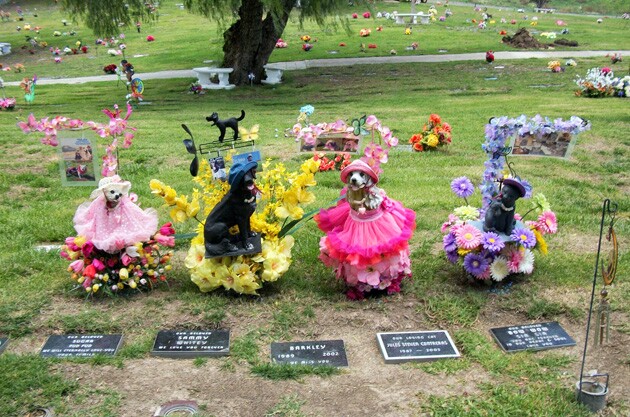
I am not a huge animal person. I adore my cat, and I like other people's dogs once I know them, but I cannot call myself an animal lover of any great distinction. So as I drive down the 101 to Calabasas, headed towards L.A. County's oldest and best known pet cemetery, I am not sure what to expect. I pull off the 101, drive through a small cluster of industrial warehouses, and take a sharp left on a dirt road, which leads into the 10-acre park. I am instantly struck by its understated loveliness. With its rolling green hills, low headstones, old trees, and plethora of decorations, it is like any other well-kept, un-exceptional California cemetery.
Of course, there are some differences. There are the names -- Satan, Rags, Andy MacTavish, Gumbo Gizzy, Natasha Foxy, Betsy Ross, Peyote, Kris Kringle, Myra Breckenridge, Miss Nanook, Billie Bounce (the horse), Poupoulie Sapse, Tetee(the bird), and Snoopy, "a lady who thought she was people." The faded portraits are of long departed horses and rabbits, and the statuary includes studies of kittens, lions and turtles. Overall, many of the graves seem to be lovingly tended with much greater frequency than the human ones I usually encounter. Milk-Bone wind-chimes and Christmas ornaments are strung in trees, windmills shaped like cats riding bicycles turn in the breeze, and statues of St. Francis of Assisi, the patron saint of animals, are everywhere.
Occasionally, a man or woman appears carrying flowers, or to stand over the grave of a dearly departed friend. A grave digger prepares a tiny hole in the ground for an afternoon burial. In the mausoleum there are stained glass windows of happy animals that are unable to lift the gloom of its musty interior. Outside, I find myself a little sad and surprisingly touched, almost more moved than I am at cemeteries of the traditional kind. I am moved by the playful decorations, the unusually sweet epitaphs, and the overwhelming feeling that there are over 40,000 animals here who were some man or woman's very best friend.
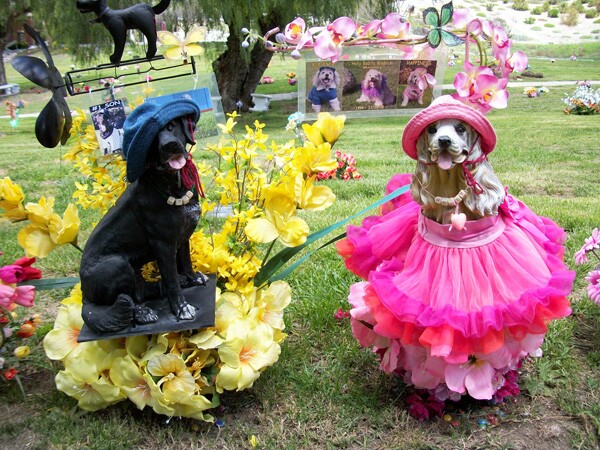
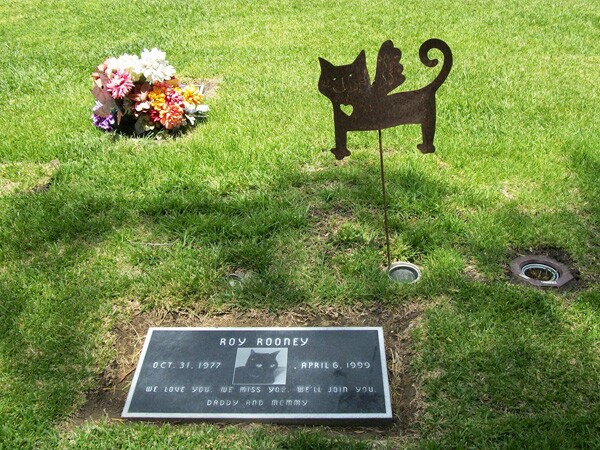
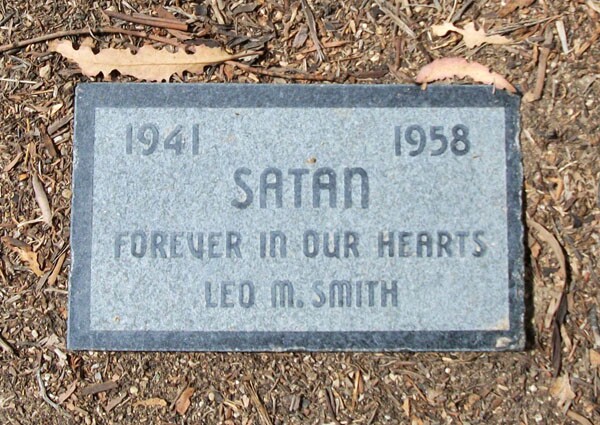
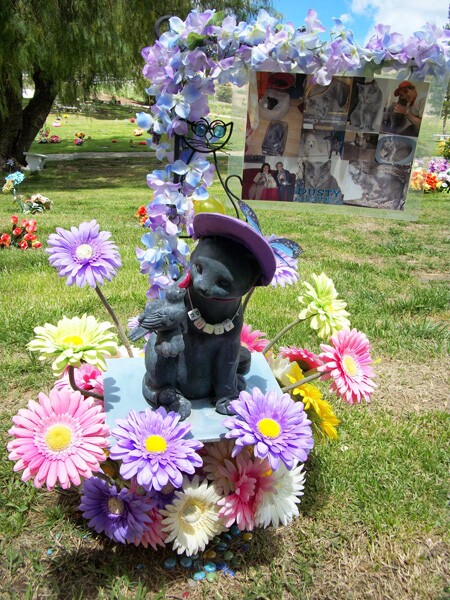
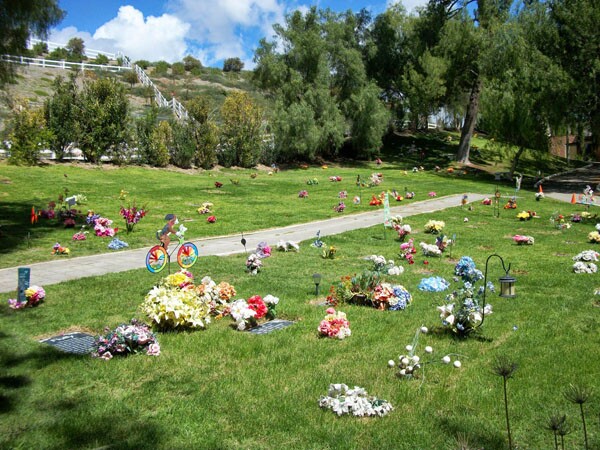
Pancho (monkey) Says Goodbye to Titine (pizote)
Puzzums, a waif who rose to be a film star, will be buried at 4 p.m. today. The interment will take place at the Los Angeles Pet Cemetery, for Puzzums was a cat-a trained cat with innumerable film appearances to his credit in the last eight years. His last was in the Will Rogers picture, "Handy Andy." -- L.A. Times, August 13 1934
An insignificant figure, dejected and with all the appearance of a man who had lost his last friend (which he had) stood alone in another part of the cemetery. A few years ago he had paid a $50 reward for the return of his lost pet. Last week he pawned his watch to purchase its burial lot. Sympathetic pet lovers near-by shared the flowers of their own lost dog. -- L.A. Times April 14, 1935
In 1924, Dr. Eugene C. Jones set up a veterinary practice in West Hollywood. He soon attracted an upper class clientele, which included many in the animal-mad film community. In 1928, heeding laws that stated no animals could be buried within city limits, he bought ten acres outside of rural Calabasas from disgraced Hollywood money-man and convicted embezzler, Gilbert H. Beesemeyer. The Los Angeles Pet Park was born. It is said that the first burial, in 1928, was the Jones family dog. Many other pampered animals soon joined this nameless pup.
Jones opened a mortuary on Highland Avenue, and his mother, Mattie, and brother, Rollins, helped run both the mortuary and the park. The operation had all the trappings of a human funeral parlor, with tiny caskets on display that cost anywhere from "$7.25 to several thousand dollars." 1 Twenty miles away at the cemetery, a single grave site went for as little as $12.50, while a spot for an embalmed pet in the grand 1929 mausoleum and columbarium cost an outrageous $400. When actress Marion Hopkins' Fox Terrier, Jerry, died:
She telephoned immediately to J. Paul Burlingame of the Memorial Park. In a short time a funeral car called for the body and sympathetic, dog loving hands placed the little fellow in a hermetically sealed casket. He was then taken to the cemetery and placed in his designated plot, one that had been reserved for him. Everything is arranged exactly as in the case of humans -- the owners and friends attend the funeral and excerpts from Senator Vest's famous tribute to a dog are read at the graveside. 2
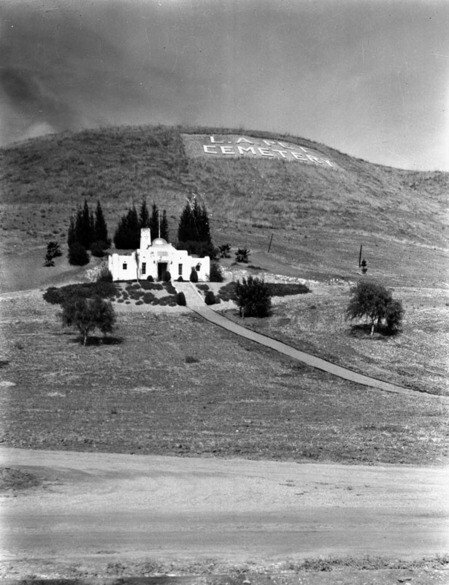
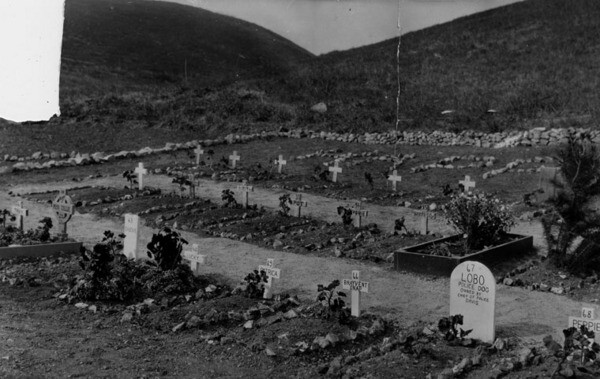
By 1932, over 750 pets lay under uniform brass markers, in urns, or in macabre "specially built crypts where bodies, placed in individual air tight compartments, undergo a process of mummification." 3 From the beginning, there was a sense of community at the little graveyard "nestled between rusty hills and leafy citrus groves." A writer at the L.A. Times reported:
Every Saturday visitors swarm to the peaceful and final camping site of their once little chums, bringing with them fragrant bunches of carnations, exquisite roses, and even exotic orchids. At Christmas time the little graves are bright with wreaths, poinsettias and holly leaves. Sometimes, even tiny trees, decorated with silver bells and tinsel, are placed on the graves. 4
The stories of the animals buried in these graves were as interesting as any human's. There was Kabar, the Doberman Pinscher given to Rudolph Valentino by a swooning Belgian diplomat. After Valentino's death, it was said that Kabar travelled the country looking for his master, only to return to Valentino's Falcon Crest estate, where he died of a broken heart. Every year, the infamous "lady in black" would supposedly visit Kabar's grave on the same day she visited that of his master.
Titine the pizote, an exotic animal from Panama that was "the size of a rabbit, had a face of an anteater and the tail of a cat," was killed by a cat. His best friend Pancho, a white faced monkey, was inconsolable. At Titine's graveside service it was reported that Pancho "rent the air with genuine grief." 5
At the well-attended funeral of Milton Sill, the Bakersfield German Shepherd famed as the "dog who knew everything," (even how to spell) 6 it was observed that his steel casket was lined with a toy Pluto, his favorite rubber bone, his collar, and dog license. Louie, a recently discovered mixed-collie pup who was slated to appear in an important movie, shut down a million dollar production when he was killed by a hit and run driver in an expensive automobile. The 1938 graveside funeral of Jiggs, the 80-pound star chimpanzee, was purportedly attended by co-stars including Dorothy Lamour, Ray Milland, and Bing Crosby. Jiggs had made $100 a day, had a social security card, and was "a member in good standing of the Screen Actors Guild." 7
In 1947, "an awfully well turned out guy" 8 came to interview Mr. Parks, one of the managers at the cemetery. By this time the cemetery was famous. It contained the remains of Leo, the MGM lion, and Petey, the dog from the "Our Gang" series. It was also the eternal home to pets owned by famous folks like Humphrey Bogart, Charlie Chaplin, John Gilbert, Dolores Del Rio, and Mae West. The man, who Mr. Parks remembered as "Mr. Wall," was Evelyn Waugh, and his 1948 satire about the American death industry, "The Loved One" would forever immortalize the cemetery as "Happier Hunting Ground."
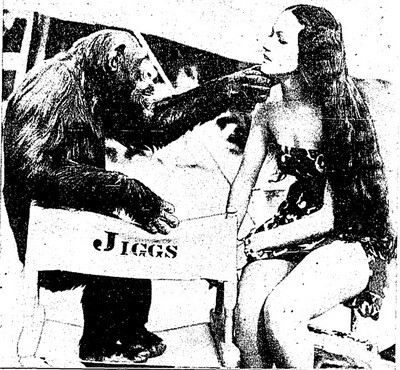
Room 8
I'm sure it sounds crazy to some people. But the pet park is a place you can go out and visit. My dog was like my child. It's difficult for some people to understand. They think you're some kind of kook to come here to visit every week. -- L.A. Times, December 29, 1986
In 1968, the cemetery welcomed one of its most beloved tenants. His name was "Room 8." "Room 8" was a portly striped tabby cat who mysteriously showed up at Echo Park's Elysian Heights Elementary School in 1952. He would stay there each school year, sunning on students' desks, and leave during the summer, always returning on the first day of the fall term. He became a celebrity, the subject of his very own book, and guest starred on Art Linkletter's "House Party," and in a TV documentary. His gravestone continues to be one of the cemetery's most popular attractions.
The '70s and '80s were filled with strange and strained occurrences. In 1973, the Jones family donated the cemetery to the Los Angeles SPCA. In 1978, L.A. conceptual artist Jeffery Vallance attracted national attention when he held a funeral for a chicken named "Blinky, the friendly hen." The hen was encased in a light blue coffin with pink satin lining, and buried at a plot in the cemetery. Blinky was a Foster Farms fryer, purchased by Vallance at a Canoga Park Ralph's Supermarket. Ten years later, he would have the body exhumed so an autopsy could be performed by UCLA's head of pathology. The tenth anniversary exhibit on the life of Blinky, at the Rosamund Felsen Gallery in Los Angeles, featured a "shroud of Blinky," and a recreation of the cemetery's viewing room, with a rubber chicken lying in state. Blinky was later reburied at the cemetery.
By this time, the L.A. institution, which now included around 40,000 graves, could hardly be bothered by the antics of Vallance. In 1983, the SPCA decided to sell the cemetery, which it was running at a loss. Developers, eager to snap up acreage in booming Calabasas, were opposed by a group of plot owners called SOPHIE (Save Our Pets' History in Eternity). Four "exhausting" years of passionate negotiations, lawsuits and fundraising followed. The tight knit community of animal lovers succeeded in raising $100,000 to buy the cemetery. They also established a perpetual care endowment to satisfy surrounding developers' concern that the property would eventually fall into disrepair. In 1986, SOPHIE officially took control of the cemetery.
"This has been our hope and prayer," one plot owner exclaimed, "thank God it's come to pass." 9
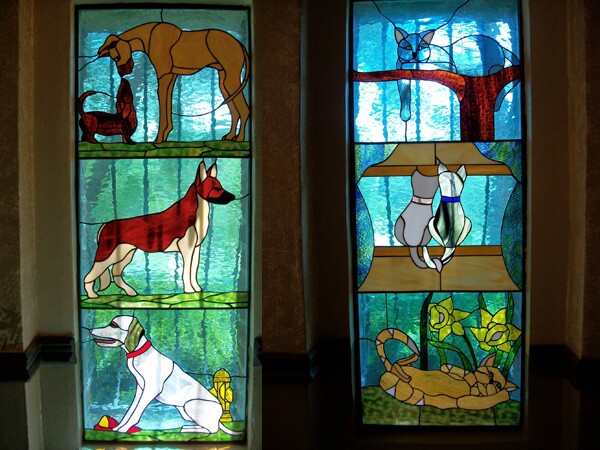

Uneasy Peace
"It is just a pet cemetery," said one dissident who asked that his name not be used because he fears retribution against his girlfriend's dead pets. "It's not like running the Hilton Hotel . . . They just keep the place clean and keep the records in order. It is about as easy as a paper route, but they are making it into something like Watergate. -- L.A. Times, November 1, 1992
Every cemetery usually includes at least one murder victim, and the L.A. Pet Memorial Park is no exception. On December 26th, 1989, a mailman named Floyd Sterling was making his daily rounds in the town of Pacoima. He came to the home of Tammie Brody and her ten year old son. Brody walked outside with the mailman's Christmas gift, a bottle of vodka tied with a green bow. Before she could give it to him, Sterling pulled out a gun and fatally shot Skippy, Brody's two year old German Shepherd. Sterling claimed he was only trying to frighten the dog, who he said had bitten him before. Brody and her son witnessed the shooting, and claimed the dog was running when shot, which an autopsy report seemed to confirm. After the dog was shot, one neighbor reported asking if the dog was ok. "I hope not," Sterling replied. 10
A flurry of international media attention latched on to this curious story. Sterling was suspended and charged with three felonies. The mortified postal service promised to pay for Skippy's memorial. The funeral at the cemetery was clogged with media. Skippy was placed in a white casket, lined with orange silk. Eight family members stood around the grave as the casket was lowered into the ground. The family quickly left the cemetery, cameramen trailing behind them. The saga of Little Skippy had come to an end.
The image of a close-knit community, which SOPHIE members portrayed to the outside world, was frayed in 1992, when a nasty battle for cemetery control revealed deep tensions between plot owners. A splinter group called SOS (short for Save Our SOPHIE) was formed, calling for reform of the cemetery's management. This whirlwind in a teacup was a "battle of innuendoes and smears," in which both sides sent dozens of fliers to plot owners with sensational accusations. Fears of development were stoked, and personal animosities simmered. One woman so hated the cemetery manager, she scheduled her Golden Retriever's burial for a time she knew the woman would not be present, stating:
No way was I going to sob over my dog's grave with her around. It was like planning for Desert Storm so I could have my private moment without her on my back. . . . I'll never get over that for the rest of my life. 11
It seems time has mellowed both sides, and today SOPHIE, which boasts about 500 members, still owns and runs the charming cemetery. Its famous clientele has increased over the years, with the pets of Steven Spielberg, Peter Falk, Diana Ross, Tori Spelling, Bob Barker, and William Shatner all buried there. Every last Saturday of each month a candlelight memorial remembrance is held for those who have lost their pets. One particularly heartbreaking headstone perhaps sums up the feelings that many people at the cemetery find bonds them together, and helps to keep them apart:
My love, my beauty, my goofy-goof, my best friend, sweet brother. My heart aches so deeply without you. You will be with me for all eternity. Loving. I love you so very much. Mommy. 12
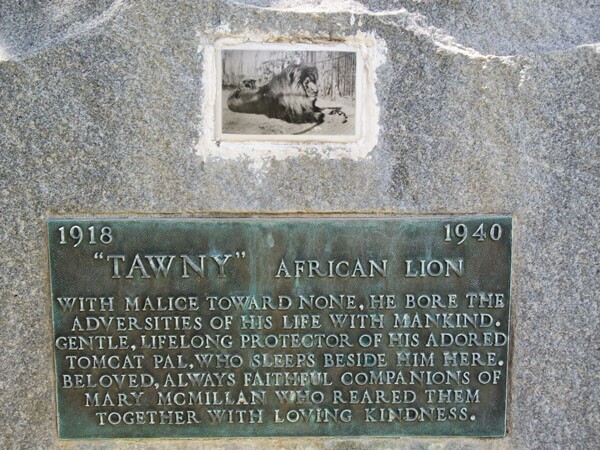
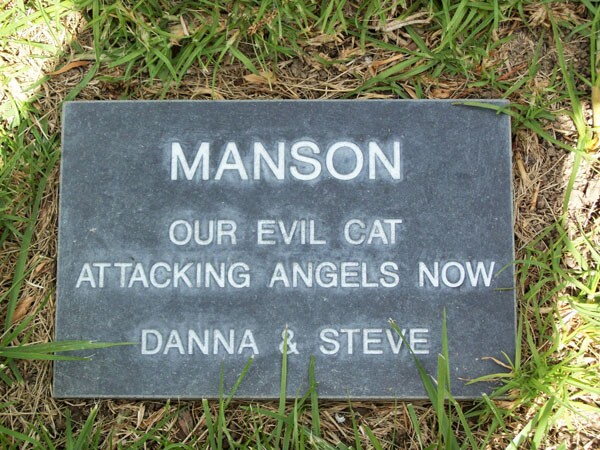

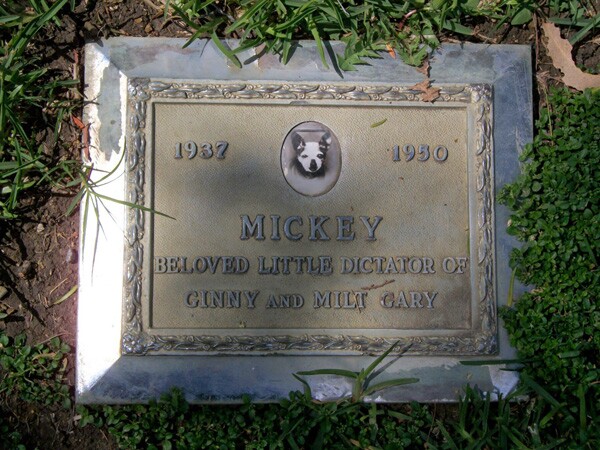
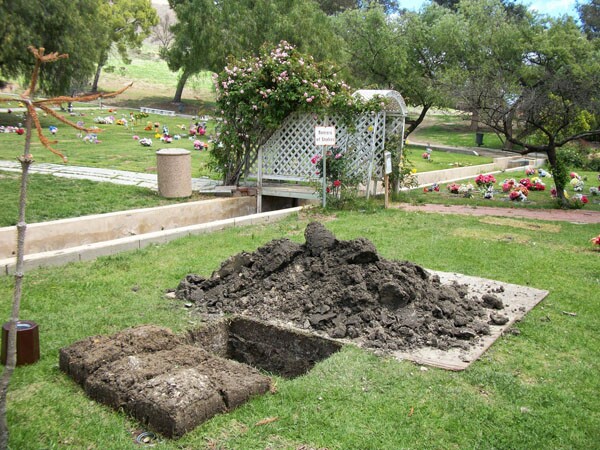

Additional Photos by: Hadley Meares
_____
1 "Where sleeping dogs lie" L.A. Times, October 16, 1932
2 Ibid.
3 Ibid.
4 Ibid.
5 Ibid.
6 "Faithfulness of dog rewarded by fine funeral" Los Angeles Times, April 4, 1937
7 "Chimp actor dies" L.A. Times, March 2, 1938
8 "Much Mouk and Googies" L.A. Times, July 16, 1967
9 "Departed pets to rest in peace" L.A. Times, December 29, 1986
10 "Postal service pays" L.A. Times, January 5, 1990
11 "The twisted tale of a beastly battle" L.A. Times, November 1, 1992
12 "Pet lovers decorate" The Charleston Gazette December 25, 2009


